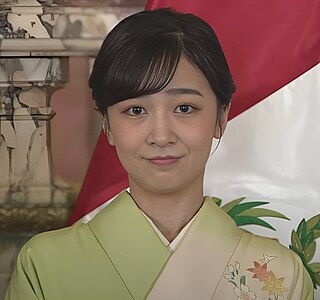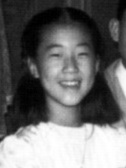
Naruhiko, Prince Higashikuni was a Japanese imperial prince, a career officer in the Imperial Japanese Army and the 30th prime minister of Japan from 17 August 1945 to 9 October 1945, a period of 54 days. He is the shortest-serving prime minister, resigning after fifty-four days. An uncle-in-law of Emperor Hirohito twice over, Prince Higashikuni was the only member of the Japanese imperial family to head a cabinet and was the last general officer of the Imperial Japanese military to become prime minister. He was the founder of the Chiba Institute of Technology. He was one of the longest-lived members of any royal family.

Nagako, posthumously honoured as Empress Kōjun, was a member of the Imperial House of Japan, the wife of Emperor Shōwa (Hirohito) and the mother of Emperor Emeritus Akihito. She was Empress of Japan from 1926 until her husband's death in 1989, making her the longest-serving empress consort in Japanese history.

Naruhito is Emperor of Japan. He acceded to the Chrysanthemum Throne following his father's abdication on 1 May 2019, beginning the Reiwa era. He is the 126th monarch according to Japan's traditional order of succession.

Michiko is a member of the Imperial House of Japan. She was Empress of Japan as the wife of Akihito, the 125th Emperor of Japan reigning from 7 January 1989 to 30 April 2019.

Sadako Kujō, posthumously honoured as Empress Teimei, was the wife of Emperor Taishō and the mother of Emperor Shōwa of Japan. Her posthumous name, Teimei, means "enlightened constancy".

Kuniyoshi, Prince Kuni was a member of the Japanese imperial family and a field marshal in the Imperial Japanese Army during the Meiji and Taishō periods. He was the father of Empress Kōjun, and therefore, the maternal grandfather of Emperor Emeritus Akihito and great grandfather of Emperor Naruhito.

Sayako Kuroda, formerly Sayako, Princess Nori, is the youngest child and only daughter of Emperor Emeritus Akihito and Empress Emerita Michiko, and the younger sister of the current Emperor of Japan, Naruhito. She is an imperial Shinto priestess of the Ise Grand Shrine, currently serving as the Supreme Priestess.

Fumihito, Crown Prince Akishino is the heir presumptive to the Japanese throne. He is the younger brother of Emperor Naruhito, and the younger son of Emperor Akihito and Empress Michiko. Since his marriage in June 1990, he has had the title Prince Akishino and has headed his own branch of the imperial family.

Kiko, Crown Princess Akishino, is the wife of Fumihito, Crown Prince of Japan. Her husband is the younger brother and heir presumptive of Emperor Naruhito and the second son of Emperor Emeritus Akihito and Empress Emerita Michiko.

Takahito, Prince Mikasa was a Japanese prince, the youngest of the four sons of Emperor Taishō (Yoshihito) and Empress Teimei (Sadako). He was their last surviving child. His eldest brother was Emperor Shōwa (Hirohito). After serving as a junior cavalry officer in the Japanese Imperial Army during World War II, Takahito embarked upon a post-war career as a scholar and part-time lecturer in Middle Eastern studies and Semitic languages; he was especially interested in Jewish studies.

Masahito, Prince Hitachi is a member of the Imperial House of Japan, the younger brother of Emperor emeritus Akihito and the paternal uncle of Emperor Naruhito. He is the second son and sixth born child of Emperor Shōwa and Empress Kōjun and is third and last in line to the Chrysanthemum Throne. He is mainly known for philanthropic activities and his research on the causes of cancer.

Kikuko, Princess Takamatsu, born Tokugawa Kikuko, was a member of the Japanese imperial family. The Princess was married to Nobuhito, Prince Takamatsu, the third son of Emperor Taishō and Empress Teimei. She was, therefore, a sister-in-law of Emperor Shōwa and an aunt by marriage of the following emperor, Akihito. She was mainly known for philanthropic activities, particularly her patronage of cancer research organizations. At the time of her death, Princess Takamatsu was the oldest member of the Imperial Family.

The Gakushūin, or Gakushuin School Corporation (学校法人学習院), historically known as the Peers' School, is a Japanese educational institution in Tokyo, originally established as Gakushūjo(学習所) to educate the children of Japan's nobility. The original school expanded from its original mandate of educating the social elite and has since become a network of institutions which encompasses preschool through tertiary-level education.

The Imperial House is the reigning dynasty of Japan, consisting of those members of the extended family of the reigning emperor of Japan who undertake official and public duties. Under the present constitution of Japan, the emperor is "the symbol of the State and of the unity of the people". Other members of the imperial family perform ceremonial and social duties, but have no role in the affairs of government. The duties as an emperor are passed down the line to their male children. The Japanese monarchy is the oldest continuous hereditary monarchy in the world. The imperial dynasty does not have a name, therefore its direct members do not have a family name.

Princess Kako of Akishino is the second daughter of the Crown Prince and Crown Princess of Japan and a member of the Japanese imperial family. She is a niece of Emperor Naruhito and the second-eldest grandchild of Emperor Emeritus Akihito and Empress Emerita Michiko.

Prince Kaya Tsunenori, was the second head of the Kaya-no-miya collateral branch of the Japanese imperial family. A general in the Imperial Japanese Army, he was first cousin to Empress Kōjun (Nagako), the wife of Emperor Shōwa (Hirohito).

Atsuko Ikeda, formerly Atsuko, Princess Yori, is the fourth daughter of Emperor Shōwa and Empress Kōjun. As such, she is the older sister of Emperor Emeritus Akihito and paternal aunt of Emperor Naruhito. She married Takamasa Ikeda on 10 October 1952. As a result, she gave up her imperial title and left the Japanese Imperial Family, as required by law. Later, she served as the most sacred priestess (saishu) of the Ise Grand Shrine between 1988 and 2017. In April 2024 the former princess adopted Motohiro Nozu CEO of Kabaya.

Shigeko Higashikuni, born Shigeko, Princess Teru, was the wife of Prince Morihiro Higashikuni and eldest daughter of Emperor Shōwa and Empress Kōjun. She was the eldest sister to Emperor Emeritus Akihito, and paternal aunt to Emperor Naruhito.

Kazuko Takatsukasa, formerly Kazuko, Princess Taka, was the third daughter of Emperor Shōwa and Empress Kōjun. She was an elder sister to Emperor Emeritus Akihito, and paternal aunt to Emperor Naruhito. She married Toshimichi Takatsukasa on 21 May 1950. As a result, she gave up her imperial title and left the Japanese Imperial Family, as required by law.

Akihito is a member of the Imperial House of Japan who reigned as the 125th emperor of Japan from 1989 until his abdication in 2019. The era of his rule was named the Heisei era, Heisei being an expression of achieving peace worldwide.



























